What is the Norwood Hair Loss Scale?
Male-pattern hair loss (MPHL), also called androgenetic alopecia, is the most common form of hair loss. The areas prone (frontal forelock, mid-forelock, and vertex) to balding in androgenetic alopecia are shown in the graph below.
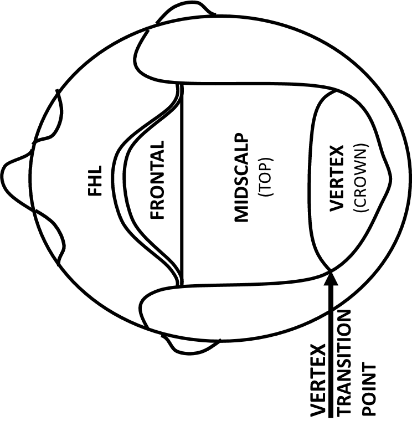
Androgenetic alopecia is an aging process that affects every male starting at puberty and progressively worsens with age. A patient’s genetics will dictate the severity of hair loss. This hair loss can have significant psychosocial effects since the individual may be perceived as less attractive and older. It was necessary to develop a classification system to determine the extent of MPHL to more accurately treat and assess the progression. The first classification system was developed and published by a dermatologist, Dr. Hamilton, in 1951(1). Dr. Norwood, another dermatologist, published a much larger study of the extent of hair loss in men in 1975 and modified Dr. Hamilton’s classification to better conform to the observed stages of hair loss (2). The Norwood classification of male pattern hair loss is now the most commonly used scale in classifying MPHL. The Norwood Classification has seven stages that show progressively more extensive patterns of hair loss.
Importance of the Norwood Hair Loss Scale
The Norwood classification system is essential in order to develop medical studies evaluating the medical and surgical treatments for male pattern hair loss. It is also essential in developing the medical and surgical plan for each individual patient. I tell my patients who are experiencing significant male pattern hair loss that the treatment is not “one and done”, but the treatments need to be continued to maintain the effects in this journey of aging, which is intimately intertwined with the Norwood stages of male pattern hair loss.
As a physician, it is imperative to understand that the younger a patient starts progressing through the various stages of MPHL, the more likely they will end up with the most advanced Norwood classification. This is why it is of the utmost importance for the physician to convey the need for the preventative medical treatments (finasteride and minoxidil) in slowing the progressive nature of male pattern hair loss. This foresight is also fundamental in developing a surgical treatment that will not only look natural today but also look natural decades following the hair transplant. Unfortunately, most doctors performing hair transplants have no formal training in a medical residency. This lack of knowledge and foresight of the progressiveness of the Norwood classification causes many untrained doctors to create hair patterns that are not natural. A natural-looking hair transplant should mimic one of the stages of the Norwood classification. Unfortunately, this dictates that the younger a patient is and the more extensive his present hair loss, an ethical and educated physician must create a hair transplant that “mimics” a more advanced stage of the Norwood classification in order to keep him looking natural for the rest of his life.
Detailed Breakdown of Norwood Scale Stages
The stages of the Norwood scale are outlined below. Each will be examined in detail to highlight its characteristics and treatment options.
Stage 1
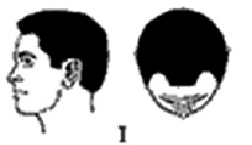
Identification
Stage 1 is represented by patients with no or minimal recession along the anterior border of the frontotemporal region (e.g., most pre-pubertal children).
Treatment Options
Patients in this stage do not need to be treated medically or surgically.
Stage 2
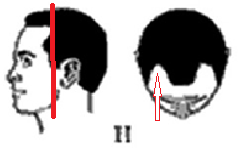
Identification
Stage 2 is the beginning phase of the hairline receding posteriorly, making the frontotemporal triangles more pronounced (red arrow). Notice the apex of the recession (red line) is still significantly anterior to the ear.
Treatment Options
This early phase of male pattern hair loss should only be treated if it bothers the patient. If it bothers the patient, the most appropriate treatment is the preventive medical treatments (finasteride and minoxidil) to stop and slow the progression of their hair loss. Hair transplant surgery should be withheld at this stage.
Stage 3
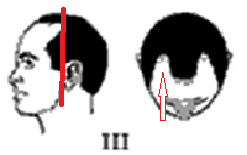
Identification
Stage 3 is noted by further posterior recession of the frontotemporal triangle (red arrow). Note that the apex of the recession (red line) has reached the anterior part of the ear (i.e., the midcoronal line).
Treatment Options
Treatment at this stage is dictated by a person’s age and personal goals. The most important treatment at this stage is preventative medical therapies to try to keep all the existing hair in the areas prone to balding. Hair transplants are an excellent option if the patient is realistic about his goals. The younger a patient’s age, the more likely hair transplants should be withheld, since it could create a situation that will not look natural as the patient ages.
Stage 4
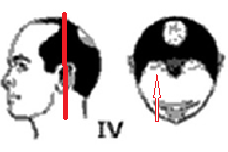
Identification
Stage 4 is noted by further poster progression of the frontotemporal triangle (red arrow). Note that the apex of the recession (red line) has extended posteriorly to the mid part of the ear (beyond the midcoronal line). Also, the miniaturization of the hair has progressed to the point where the circular area of balding becomes noticeable in the vertex.
Treatment Options
The preventative medical treatments are vital to slow the progression of male pattern hair loss. Hair transplants are an excellent option to increase the density in the balding region. Young patients should understand the risk of hair transplants that bring the frontal hairline too low, since it will use more of the very limited good genetic hair taken from the sides and back. This also could eventually lead to the hair transplant no longer looking natural as the patient ages.
Stage 5
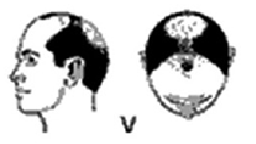
Identification
Stage 5 is noted by further recession of the balding frontotemporal triangles and expanded circular thinning in the vertex. There is still a bridge of hair in the mid-forelock separating the bald frontal forelock from the balding vertex.
Treatment Options
Preventative medical therapies are still important to keep the existing hair that is currently there. Hair transplants are a great option to reframe the face and restore the hairline. The younger the patient’s age, the more the hairline has to recede in order to maintain a natural framing of the face as the patient ages.
Stage 6
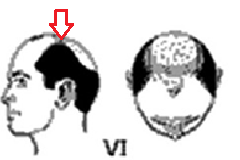
Identification
Stage 6 is noted by the loss of the bridge of hair in the mid-forelock that separates the frontal forelock from the vertex. Note that the parietal humps still possess hair (red arrow).
Treatment Options
I use the analogy that tooth decay, similar to androgenetic alopecia, is an aging process that is slowed by the preventative medical therapies (i.e., toothpaste). Even if you have only 6 teeth left in your mouth, those teeth still benefit from continual brushing with toothpaste. Similarly, there is still some value to the preventative medical therapies for existing hair in the balding-prone area. Hair transplants are an excellent option to conservatively reframe the face and give a much more youthful appearance.
Stage 7
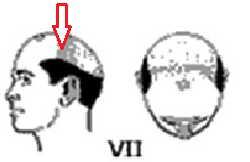
Identification
Stage 7 is the last stage noted by further progression of the balding down the sides of the scalp with the complete loss of the parietal humps (red arrow).
Treatment Options
The preventative medical therapies are still useful to save the last remaining existing hairs in the balding region, but it would have been much more of a benefit if started in the early stages of the Norwood classification. Hair transplants are still a viable option to give a much more youthful appearance; however, the patient’s goals must be conservative and realistic.
Limitations of the Norwood Scale
Over the decades, there have been many studies to try to create the ideal classification system for androgenetic alopecia; however, there are vastly different genetic factors in the human population. Therefore, there is no perfect classification that encompasses all human hair loss patterns. The Norwood classification is the most widely used scale for men with androgenetic alopecia, but it is not accurate in most women’s pattern of hair loss. The other problem when it comes to the Norwood classification is that many doctors are not educated on what defines the different stages, therefore, these doctors misclassify patients. When it comes to androgenetic alopecia, there is one constant: no matter what the pattern an individual follows, the hair loss progressively worsens as one ages.
My Experience
Androgenetic alopecia is an aging process that continues to progress as the patient ages, as exemplified by the Norwood Stages. A patient’s individual genetics determines the rate of progression through the Norwood stages. The preventative medical therapies slow the rate of progression through the Norwood stages, therefore, patients on the medical therapies will decrease the need for numerous hair transplant surgeries as they age to keep up with an individual’s progressive hair loss.
A patient’s Norwood classification does not necessarily make him/her a good or bad hair transplant candidate. What makes an individual patient a good or bad hair transplant candidate is “if the patient is realistic about his or her hair transplant goals”. It is incumbent upon an ethical and educated physician to make sure the patient’s hair transplant goals are realistic, not only today but also tomorrow, and also understands that there is no perfect treatment for androgenetic alopecia. A physician must do what is in the best interest of the patient, and sometimes that is going against the patient’s wishes and not performing the hair transplant. If I agree to perform a hair transplant on an individual patient, I do not lose any sleep worrying if a hair transplant will look natural. I know it will always look completely natural.
References
- Hamilton JB. Patterned loss of hair in man; types and incidence. Ann N Y Acad Sci. 1951;53:708–28. doi: 10.1111/j.1749-6632.1951.tb31971.x. [DOI] [PubMed] [Google Scholar]
- Norwood OT. Male pattern baldness: Classification and incidence. South Med J. 1975;68:1359–65. doi: 10.1097/00007611-197511000-00009. [DOI] [PubMed] [Google Scholar]

Dr. Paul J. McAndrews is a world-renowned expert in hair loss and hair restoration, and one of only two physicians to have served as President of both the ISHRS and ABHRS. He is a Clinical Professor at USC/LAC Medical Center and an Expert Medical Reviewer for the California Medical Board. Known for his artistic, patient-focused approach, Dr. McAndrews performs one hair transplant per day to ensure exceptional, individualized results.
